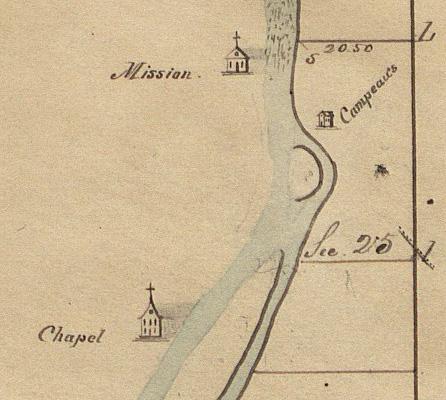Lucius Lyon (February 26, 1800 – September 24, 1851) was a U.S. statesman from the state of Michigan. He was born in Shelburne, Vermont, where he received a common school education and studied engineering and surveying. He moved to Bronson (now Kalamazoo), Michigan, in 1821 where he became a land surveyor, eventually becoming the Deputy Surveyor General of the Michigan Territory.
In 1829, he was commissioned to rebuild the Fort Gratiot Lighthouse at the entrance to the St. Clair River from Lake Huron.
In the 1830s, he surveyed a portion of what would become the boundary between Illinois and Wisconsin. Lucius Lyon placed the initial point of the Fourth Principal Meridian on December 10, 1831. He also participated in the survey parties which established the baseline and meridian used to define townships in Wisconsin. His field notebooks recorded considerable detail about the land he surveyed, providing a rich source of information for later researchers.
1831 Survey of Grand Rapids by Lucius Lyon
US Government – 1831
Section 25 of the of the April 1831 government survey map of Township 7 North, Range 12 West by Deputy Surveyor Lucius Lyon. On the west side of the Grand River a mission (Baptist) at the south end of the rapids and chapel (Roman Catholic) are depicted, and on the right a house indicating the Campeaus
Source: Surveying the Land, Grand Rapids Historical Commission, December 1, 2006.
From May 11 to June 24, 1835, he was a member of the convention that drafted the first Michigan Constitution, which voters adopted in October, 1835. In November 1835, Lyon was elected as U.S. Senator. However Michigan’s delegation to Congress was seated as “spectators”, pending Michigan’s admission as a state. Upon Michigan’s admission as a state on January 26, 1837, Lyon served as a full U.S. Senator until 1839.
On March 28, 1836, Lyon was a witness to the Treaty of Washington of 1836, in which the Ottawa and Chippewa nations of Indians ceded much of the land in the northern portion of the Lower Peninsula of Michigan. He was also witness to a separate treaty on May 9, 1836 with the Chippewa in which additional land was ceded.
He did not run for reelection in 1839 and moved to Grand Rapids, Michigan. He was a member of the Board of Regents of the University of Michigan, 1837–1839, and was appointed Indian commissioner at La Pointe, Wisconsin in 1839. He was elected as a Democrat from the newly formed 2nd district in Michigan to the 28th Congress, serving one term from March 4, 1843 to March 3, 1845. He was the first person to represent Michigan in both the U.S. Senate and U.S. House. In both houses of Congress he served on the Committee on Public Lands.
He did not run for reelection and was appointed by President James K. Polk in 1845 as surveyor general for Ohio, Indiana, and Michigan. He moved the office for this post from Cincinnati, Ohio to Detroit, Michigan and served in this capacity until 1850.
Lyon was also a major financial backer of Hiram Moore, an inventor and a founder of the village of Climax, Michigan. Moore reportedly invented a working farm machine in the 1830s and 1840s that “combined” the functions of a threshing machine and a reaper, decades before combines were commonly available. Moore’s designs were allegedly copied by Cyrus McCormick and despite many years of legal wrangling, Moore was unsuccessful in pursuing his patent claims.
He also owned a large tract of land in Grand Rapids, Michigan and engaged in a feud over platting the area with the other major land owner, Louis Campau. Lyon wanted to call it the village of Kent rather than Grand Rapids. Lyon is also remembered in Grand Rapids for attempting to commercialize salt deposits in the city by boring a hole and extracting salt from the brine water below.
In politics he was Democrat, in religion a Swedenborgian. He was also a temperance advocate associated with the Washingtonian movement.
Lucius Lyon died in Detroit and was interred in Elmwood Cemetery.
South Lyon, Michigan, Lyon Township, Oakland County, Michigan, Lyon Township, Roscommon County, Michigan, Lyon Lake, Fredonia, Michigan and Lyons Township, Michigan are all named after Lucius Lyon. Notably, in 1836, Lucius Lyon purchased much of the property in a small village in Ionia County, Michigan and renamed it Lyons, Michigan. He platted the village, established the first post office and installed his brother, Truman, as the first postmaster, although he never lived in the village.
Lucius Lyon was also honored by having the first Grand Rapids Community Legends Project statue forged in his honor. It is now located in Lyon Square.
Sources :
Dodge, Elise F. “Pioneers of the Statehood Era: Lucius Lyon.” Michigan History 71 (November/December 1987)
Lucius Lyon : an eminently useful citizen / by Kit Lane. Douglas, Mich. : Pavilion Press, [1991] Available through interlibrary loan via MelCat.

